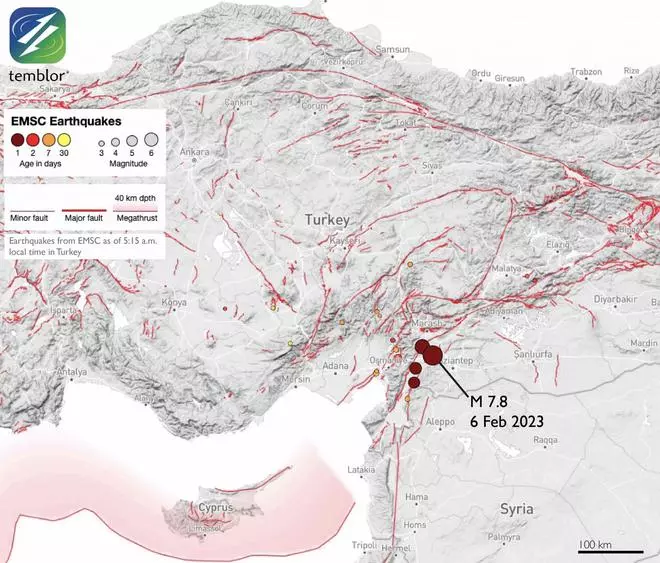ThiruvananthapuramAside from the massive size and shallow depth of the earthquake that struck the Turkey-Syria border on Monday - and from the fact that it struck in a heavily populated area - one of the reasons buildings in the region are not built to withstand large earthquakes. Temblor Inc, a catastrophe modelling company specialising in seismic hazard and risk assessment, said the magnitude-7.8 quake occurred shortly after 4 am local time on Monday. Not long after, a magnitude-6.7 aftershock too struck the region.

Map showing location of magnitude-7.8 earthquake in Turkey-Syria early on Monday morning. | Photo Credit: Temblor Inc
Left-lateral motion
The earthquake motion was left-lateral (whichever side of the fault you are on, the other side moved to the left). This is consistent with the motion of the East Anatolian Fault, having a slip rate between 6 and 10 millimetres per year. Early ‘Did you feel it?’ reports suggest that the strongest shaking occurred to the North-East of the epicentre, near the cities of Adiyman and Malaya.
People search through rubble following an earthquake in Adana, Turkey February 6, 2023. | Photo Credit: IHA
This suggests that the rupture propagated hundreds of kilometres to the North-East. Turkey’s other major fault system, the North Anatolian Fault, is right-lateral. Central Turkey is being squeezed westward between these two great faults, caught in a tectonic vice, spilling into the Mediterranean, toward Crete. This happens because Turkey is being pushed northward by the Arabian Plate.
People search for survivors under the rubble following an earthquake in Diyarbakir, Turkey February 6, 2023. REUTERS | Photo Credit: SERTAC KAYAR
Resonates with Himalayas
Temblor Inc quoted Haluk Eyidoğan, a professor of seismology at Istanbul Technical University, Turkey, writing in a previous story for Temblor Earth News: “We are sadly watching how the stone masonry and adobe masonry structures in rural areas (in the quake-hit region) are weak, and the so-called reinforced concrete carcass multi-story buildings are demolished in cities.”
Rescuers work near the site of a collapsed building, following an earthquake, in Hama, Syria February 6, 2023. | Photo Credit: FIRAS MAKDESI
Nearer home, this ironically resonates with the seismic history and profile of the Himalayas where, given the prevalence of poorly-assembled concrete structures, it is possible earthquakes could result in significant loss of life, according to Roger Bilham, renowned US-based seismologist and geologist.
People gather as rescuers search for survivors under the rubble, following an earthquake, in rebel-held town of Jandaris, Syria February 6, 2023. | Photo Credit: KHALIL ASHAWI
Aftershocks to continue
The relatively shallow depth of Monday’s quake in Turkey-Syria - between 10-18 km below the surface - resulted in severe shaking over a large area of Turkey and Syria and parts of Lebanon, Israel and Cyprus. Aftershocks are ongoing and will continue to shake the region, Temblor said. ‘Felt reports’ have been coming into the Euro-Med Seismological Centre (EMSC) and the US Geological Survey (USGS), Temblor Inc said.
A man carries a girl following an earthquake, in rebel-held town of Jandaris, Syria February 6, 2023. | Photo Credit: KHALIL ASHAWI
Within five hours of the main shock, hundreds of people had already been confirmed dead in Turkey and Syria.Thousands of buildings throughout the region have collapsed and rescuers are searching through rubble for survivors. The USGS’s PAGER system, which estimates fatalities and economic losses from earthquakes, indicates thousands of people likely have died, with economic losses in Turkey alone in billions of dollars. The devastation is widespread and only starting to be uncovered.
People search for survivors under the rubble following an earthquake in Diyarbakir, Turkey February 6, 2023. | Photo Credit: SERTAC KAYAR
People gather as rescuers search for survivors under the rubble, following an earthquake, in rebel-held town of Jandaris, Syria February 6, 2023. | Photo Credit: KHALIL ASHAWI
Syrian refugees hit
The epicentre of the quake was near the city of Gaziantep in Gaziantep province. The province, along with neighbouring Kahramanmaras province, is currently housing hundreds of thousands of Syrian refugees. It’s cold and raining or snowing in much of the region, complicating matters for those whose homes have been destroyed or compromised. Authorities have warned residents not to return to the damaged housing.




Comments
Comments have to be in English, and in full sentences. They cannot be abusive or personal. Please abide by our community guidelines for posting your comments.
We have migrated to a new commenting platform. If you are already a registered user of TheHindu Businessline and logged in, you may continue to engage with our articles. If you do not have an account please register and login to post comments. Users can access their older comments by logging into their accounts on Vuukle.